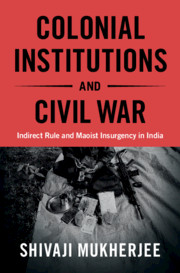Book contents
- Colonial Institutions and Civil War
- Cambridge Studies in Contentious Politics
- Colonial Institutions and Civil War
- Copyright page
- Contents
- Figures
- Tables
- Acknowledgments
- Part I Theory
- Part II Qualitative and Quantitative Testing
- 4 Qualitative Analysis of Maoist Strategy and Rebel Agency
- 5 Quantitative Testing of Effects of British Indirect Rule on Maoist Insurgency
- 6 Colonial Choice or Random Contingency? Addressing Selection Bias in British Indirect Rule
- 7 Maoist Insurgency in Chhattisgarh: The Raja of Bastar and Tribal Rebellion
- 8 Maoist Insurgency in Andhra Pradesh: The Nizam’s Shadow on Telangana
- Part III Generalizability
- Bibliography
- Index
- Series page
8 - Maoist Insurgency in Andhra Pradesh: The Nizam’s Shadow on Telangana
from Part II - Qualitative and Quantitative Testing
Published online by Cambridge University Press: 15 May 2021
- Colonial Institutions and Civil War
- Cambridge Studies in Contentious Politics
- Colonial Institutions and Civil War
- Copyright page
- Contents
- Figures
- Tables
- Acknowledgments
- Part I Theory
- Part II Qualitative and Quantitative Testing
- 4 Qualitative Analysis of Maoist Strategy and Rebel Agency
- 5 Quantitative Testing of Effects of British Indirect Rule on Maoist Insurgency
- 6 Colonial Choice or Random Contingency? Addressing Selection Bias in British Indirect Rule
- 7 Maoist Insurgency in Chhattisgarh: The Raja of Bastar and Tribal Rebellion
- 8 Maoist Insurgency in Andhra Pradesh: The Nizam’s Shadow on Telangana
- Part III Generalizability
- Bibliography
- Index
- Series page
Summary
Similar to the Chhattisgarh chapter, I use archival and interview data to do process tracing of the mechanisms for another crucial pathway case of Maoist insurgency in Andhra Pradesh. The Telangana districts of Andhra Pradesh that had Maoist insurgency were historically part of the princely state of Hyderabad where Nizam’s rule created lower levels of development and land inequality and despotic extraction, which then persisted into postcolonial times through path dependence. The Telangana peasant rebellion of 1946-49 provided rebel agency and organizational networks and was followed by the CPI-Marxist- Leninist movement in 1967-72, and culminated in the People’s War Group (PWG) Maoist insurgency in the 1980s. All these rebellions succeeded in the Telangana districts of the former princely state of Hyderabad, and not in the British direct ruled areas of Madras province that had higher levels of development and less land inequality. I also describe the history of evolution of the PWG Maoists in Telangana region of Andhra Pradesh and show how rebel agency exploited the structural conditions to create successful Maoist insurgency. Finally, I test the theory on an Assembly Constituency dataset to show that former princely state constituencies had positive correlation with Maoist control.
Keywords
- Type
- Chapter
- Information
- Colonial Institutions and Civil WarIndirect Rule and Maoist Insurgency in India, pp. 246 - 298Publisher: Cambridge University PressPrint publication year: 2021

